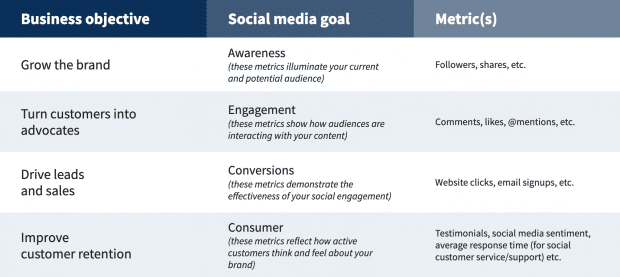If you have a personal social media account, you probably know that people don’t actually prepare what they post there.
They don’t need to follow any guidelines since the point is to share daily things without worrying too much.
However, if your brand is on social media, you have to think differently: it’s essential to plan out what you will do there, as well as think about to whom you’re talking. After all, you’re speaking directly with customers.
In this case, the platform becomes a way of generating awareness, conversions, sales, as well as boosting your Digital Marketing strategy.
If you aim to leverage those channels, you will need to develop a social media strategy. To better understand the importance of a plan like that, keep reading our article.
Here, you will see:
- What is a social media strategy?
- Why does every company need a social media strategy?
- How to build a social media strategy for your brand?
What is a social media strategy?
In an overall sense, the strategy is a blueprint to describe actions, posting schedules, objectives, as well as any point that demands your attention. You need to document everything to keep track of those factors.
This technique will allow you to think about how you want to position your business in people’s minds. You will define the tone of your voice, as well as the way you will create value for the audience to keep them interested.

For instance, a social media strategy requires the definition of your goals.
It could be to grow brand awareness, drive conversion and sales, improve customer interaction, or even turn existing customers into advocates. For each of those points, you will need a different approach.
The strategy also allows you to choose the channel in which you will focus. Facebook, LinkedIn, Instagram: it’s essential to understand which of those social channels are best to communicate with your audience.
Besides, you can even describe different goals for each platform.
For instance, you might want to drive conversions and sales through your Facebook page and create brand awareness with your LinkedIn profile.
With a blueprint to organize that, everything will be crystal clear to your team.
Another key factor is frequency. When you create a page on any platform, one question comes up: how often should I publish new content?
To answer that, you will certainly need some research regarding the right time to get people to see your posts. When you come up with the best hours, don’t forget to document it to guide other team members.
The plan also contains the metrics you look at when analyzing your pages. In case you’ve defined your goals already, it’s time to select some KPIs that perfectly represent those objectives.
If it’s awareness, you will have to pay attention to the number of shares. However, if it’s engagement, tracking the number of comments may be the better thing to do.

We can’t forget to mention a fundamental part of a social media strategy: the buyer persona.
It describes the average person you’re speaking with, so you can choose the right timing, the right approach, and the right content to share.
Having a well-crafted strategy will help you clarify your opportunities, weaknesses, strengths, and threats, as in a SWOT analysis. So, it’s like evaluating your brand to discover what you need to improve.
Why does every company need a social media strategy?
There are 3 main reasons why your company should use a social media strategy: alignment, engagement, and efficiency.
Bellow, we detailed those benefits!
Alignment
When someone interacts with your brand, they expect to receive the same good treatment — no matter what day, time, or platform they use.
Having a solid social media marketing plan will help get all of your team members on the same page. Everyone will know how to approach the user, answer their doubts, and what kind of content to publish.
A social media strategy is also good for measurement purposes. Once you know what to keep track of every week or month, you can specifically work in that direction.
Engagement
If you want your content to be shareable, valuable, and to create faithful users that recommend you everywhere, a plan is perfect for your business.
By organizing the most important elements, you will be able to come up with a way to engage your readers even more, as well as create value for them.
Data from Lyfe Marketing backs it up: 71% of customers who have had a wonderful experience tend to recommend the brand.
Efficiency
Another benefit is efficiency. With a blueprint that establishes the limits of your actions, it’s way easier to understand what you have to do to achieve your goals.
This way, you can reduce the unnecessary effort to avoid waste of both time and money with non-successful approaches.
How to build a social media strategy for your brand?
Here are some tips to keep in mind when preparing your social media plan to distribute your brand’s content.
Know how your audience consumes content
How you present the information will affect how you distribute your content across social media.
For many years, the go-to distribution strategy was to share a new piece of content on Facebook and engage with a tightly-knit audience.
This was particularly effective in the pre-mobile marketing days when desktop internet consumption was unrivaled.
But readers’ attention spans are shortening as mobile screens become the preferred option to absorb content. This means advertisers must find alternative methods to distribute information and engage with readers.
According to Marketing Land’s Aaron Strout, there are 1.68 billion active mobile social accounts globally, which is contributing to the rapid growth in global internet consumption.
This unprecedented growth means consumers are distributing more content on channels like Snapchat, TikTok, Periscope, and especially Twitter.
To increase your content’s virality, create something for those channels that will attract the attention of active users.
Look at the numbers on newer platforms
Most marketers automatically turn to Facebook and Instagram to distribute their content while many brands, especially those competing in B2B industries, are also utilizing LinkedIn.
However, don’t overlook channels that are not considered as “professional” as other platforms.
Pinterest is one of the world’s most popular social media platforms, expanding into a network of over 335 million active users since the channel’s launch in 2010.
Pinterest is the third-largest social media platform in the US, and the majority of Pinterest users interact with the platform using their smartphones.
Companies that build a visually entertaining Pinterest board can engage with their readers by posting images or videos directly or indirectly related to their core industry.
Follow the popular search trends
A good way to increase your blogs and social media traffic is by talking about trending subjects in your area.
You can even use a newsjacking strategy, where you takeadvantage of a featured event or news to promote your product or brand.
Tools like Google Trends can help you find those subjects. But keep in mind that you must approach them quickly, to not miss the timing.
Establish consistency
Your job on a social platform is to be consistent. So, it’s important to plan out how many posts you will publish in a week, in a month, and so on.
It’s crucial to consider that the team needs to set the frequency based on the audience: their preferences and habits.
Another thing to consider is that are several recommendations on how many posts are ideal for each channel.
You need to find the balance that your audience is looking for.
Use automation
Once you’ve already had everything mapped out, it’s time to set automation. This way, your team will be able to publish new content automatically, at the right time, without getting distracted and forgetful. There are a handful of tools out there to help you with this matter.
Track results
Of course, if you have a plan, you will need to look at the metrics you’ve chosen to see if things are working.
An important part of the development phase is to track the results you’ve achieved so far to make necessary adjustments.
If you expected more engagement, but you see that the numbers are not on your side, it’s time to change something.
It may be the frequency or the time of the day that the team publishes new content. To find out, the company has to check the metrics.
A social media strategy is all about defining what you want to say on your social channels: how you want to position the brand in users’ minds and how you want them to react and respond.
To get your strategy up and running, you will certainly benefit by using tools that help with automation: this way, the team can boost productivity and reduce human error.
To make your team more productive, you can use social media tools. See the main ones and what to consider when choosing one!







